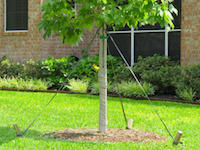
The trunk of this newly planted red maple has been wrapped to prevent sunscald.
July 11, 2023 - Scorching temperatures occur every summer in Texas and can cause ugly scars on young smooth tree trunks. Sunscald is a physiological disorder that occurs on the lower part of the trunk on the southwest side, typically on young trees. Thin barked trees such as red maples, Japanese maples, and dogwoods are most susceptible, but even young oaks can be affected.
The trunk damage is most prevalent on young, recently planted trees that have not developed a thick, corky insulating bark. The damage usually starts a few inches above the ground and extends as high as the first branches.
Sunscald is a summertime problem. Trees are kept cool by transpiration, the evaporation of water from the leaves. If a tree is newly planted or a severe drought occurs, transpiration can be slowed and temperatures in the tree can begin to increase. Not only does transpiration cool the leaves but the flow of water through the tree trunk also cools the trunk.
Temperatures near 140⁰F are lethal to most cells. In drought conditions, established oak trees with thick bark have been measured with temperatures above 135⁰F, so one can only imagine the trunk temperature of a young, newly planted red maple in an asphalt parking lot or next to the concrete in a new subdivision.
The southwest side of the tree gets the most sun, so that portion of the trunk will be the hottest. Usually there is no bark cracking when this kind of injury occurs, but a year or two after the damage a flat side of the trunk will develop and new bark growth will push in from the side of the wound, pushing the old, dead bark off the trunk. With good care, trees survive, but the trunk is disfigured for years, and the open wound can be the source for borers or a hollow tree later in the tree’s life.
Preventing sunscald injury means paying special attention to watering during the first few years of establishment for young trees. Keeping the tree trunk out of direct sunlight during the heat of summer is the first consideration. Retaining as many of the lower branches as possible on young trees and wrapping the trunk with a light-colored tree wrap that reflects the sun’s heat away can prevent the issue. Thereafter, watering during prolonged periods of drought is also important until the tree develops a large enough canopy to shade its trunk during the heat of summer.
There is no quick cure for trees that have experienced this common problem. First assess the damage and see what percentage of the tree trunk’s circumference is girdled. This will approximately equal the percentage of reduced growth and vigor in the surviving tree. If the damage is less than halfway around the tree and new callus growth is growing into it, the tree may be worth saving by cleaning the dead bark and wood from the wound, mulching, lightly fertilizing each spring and fall, and watering deeply once a month during June, July, and August. However, replacement in the fall or winter with a healthy new tree is often the best option.
Source: University of Arkansas Cooperative Extension Service
Greg Grant is the Smith County horticulturist for the Texas A&M AgriLife Extension Service. He is the author of Texas Fruit and Vegetable Gardening, Heirloom Gardening in the South, and The Rose Rustlers. You can read his “Greg’s Ramblings” blog at arborgate.com and his “In Greg’s Garden” in each issue of Texas Gardener magazine (texasgardener.com). More science-based lawn and gardening information from the Texas A&M AgriLife Extension Service can be found at aggieturf.tamu.edu and aggie-horticulture.tamu.edu.








